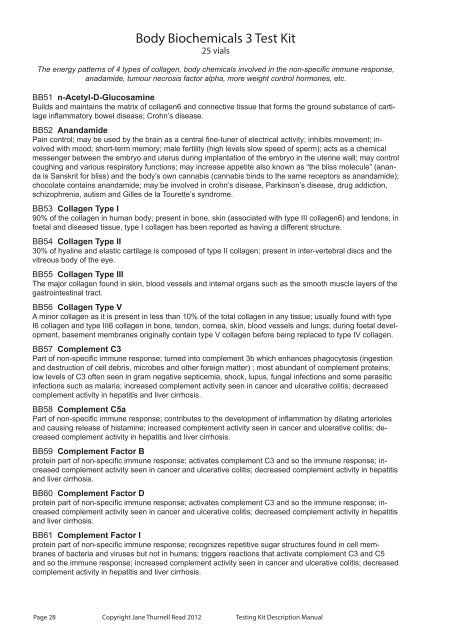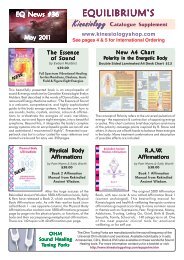Create successful ePaper yourself
Turn your PDF publications into a flip-book with our unique Google optimized e-Paper software.
Body Biochemicals 3 Test Kit<br />
25 vials<br />
The energy patterns of 4 types of collagen, body chemicals involved in the non-specific immune response,<br />
anadamide, tumour necrosis factor alpha, more weight control hormones, etc.<br />
BB51 n-Acetyl-D-Glucosamine<br />
Builds and maintains the matrix of collagen6 and connective tissue that forms the ground substance of cartilage<br />
inflammatory bowel disease; Crohn’s disease.<br />
BB52 Anandamide<br />
Pain control; may be used by the brain as a central fine-tuner of electrical activity; inhibits movement; involved<br />
with mood; short-term memory; male fertility (high levels slow speed of sperm); acts as a chemical<br />
messenger between the embryo and uterus during implantation of the embryo in the uterine wall; may control<br />
coughing and various respiratory functions; may increase appetite also known as “the bliss molecule” (ananda<br />
is Sanskrit for bliss) and the body’s own cannabis (cannabis binds to the same receptors as anandamide);<br />
chocolate contains anandamide; may be involved in crohn’s disease, Parkinson’s disease, drug addiction,<br />
schizophrenia, autism and Gilles de la Tourette’s syndrome.<br />
BB53 Collagen Type I<br />
90% of the collagen in human body; present in bone, skin (associated with type III collagen6) and tendons; in<br />
foetal and diseased tissue, type I collagen has been reported as having a different structure.<br />
BB54 Collagen Type II<br />
30% of hyaline and elastic cartilage is composed of type II collagen; present in inter-vertebral discs and the<br />
vitreous body of the eye.<br />
BB55 Collagen Type III<br />
The major collagen found in skin, blood vessels and internal organs such as the smooth muscle layers of the<br />
gastrointestinal tract.<br />
BB56 Collagen Type V<br />
A minor collagen as it is present in less than 10% of the total collagen in any tissue; usually found with type<br />
I6 collagen and type III6 collagen in bone, tendon, cornea, skin, blood vessels and lungs; during foetal development,<br />
basement membranes originally contain type V collagen before being replaced to type IV collagen.<br />
BB57 Complement C3<br />
Part of non-specific immune response; turned into complement 3b which enhances phagocytosis (ingestion<br />
and destruction of cell debris, microbes and other foreign matter) ; most abundant of complement proteins;<br />
low levels of C3 often seen in gram negative septicemia, shock, lupus, fungal infections and some parasitic<br />
infections such as malaria; increased complement activity seen in cancer and ulcerative colitis; decreased<br />
complement activity in hepatitis and liver cirrhosis.<br />
BB58 Complement C5a<br />
Part of non-specific immune response; contributes to the development of inflammation by dilating arterioles<br />
and causing release of histamine; increased complement activity seen in cancer and ulcerative colitis; decreased<br />
complement activity in hepatitis and liver cirrhosis.<br />
BB59 Complement Factor B<br />
protein part of non-specific immune response; activates complement C3 and so the immune response; increased<br />
complement activity seen in cancer and ulcerative colitis; decreased complement activity in hepatitis<br />
and liver cirrhosis.<br />
BB60 Complement Factor D<br />
protein part of non-specific immune response; activates complement C3 and so the immune response; increased<br />
complement activity seen in cancer and ulcerative colitis; decreased complement activity in hepatitis<br />
and liver cirrhosis.<br />
BB61 Complement Factor I<br />
protein part of non-specific immune response; recognizes repetitive sugar structures found in cell membranes<br />
of bacteria and viruses but not in humans; triggers reactions that activate complement C3 and C5<br />
and so the immune response; increased complement activity seen in cancer and ulcerative colitis; decreased<br />
complement activity in hepatitis and liver cirrhosis.<br />
Page 28 Copyright Jane Thurnell Read 2012 Testing Kit Description Manual



